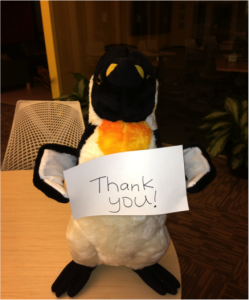Every single year, one of the biggest criticisms I hear from our mentors is this: “Your entrepreneurs don’t follow up.” In fact, Unreasonable Mentor Tom Suddes (who started 19 companies, has raised $1 billion and coached others to raise a total of $1 billion as well) even wrote a blog post about how none of our entrepreneurs followed up with him after he offered to put them in touch with incredibly relevant potential investors.
Building relationships isn’t just about charisma and polish and heart—it’s about discipline. Tweet This Quote
It’s not just our mentors. Even the investors we partner with and bring to Unreasonable events have told us, “I was ready to write a check for this entrepreneur. I told them to follow up with me, and I never heard from them again.”
What on earth is going on? Investors ready to write checks, brilliant mentors offering to make invaluable connections for our entrepreneurs, and no follow up?
What I’ve learned over the past three years of hearing this feedback is you can’t take follow up for a given. You can’t just put an entrepreneur in a room with someone you believe is good for them to connect with and say “good luck.” The truth is that while building lasting relationships and developing habits around follow up are vital to success as an entrepreneur, neither are easy to understand how to go about.
Building lasting relationships and always following up are vital to success as an entrepreneur. Tweet This Quote
I now know that one of our biggest failures as an organization that trains entrepreneurs is that we haven’t done nearly enough in supporting our entrepreneurs to engage with mentors and funders who can really help them.
Well that ends now. We are going to become fanatical about this. After racking my brain, I have attempted to come up with a memorable framework based on advice I’ve heard and my own experience that breaks down what to do before, during, and after a conversation. It’s called “Build Strong Friends”—an acronym with each word representing a different phase of engagement.
- Build outlines what you do before a meeting,
- Strong outlines what you do during the meeting, and
- Friends outlines what you do after the meeting.
So here it is: an 18-step checklist to build a relationship with potential mentors, funders, or really anyone.
Before You Meet—BUILD
1. Be with the right person. One of the most overlooked aspects of building a strong relationship is to make sure that you are sitting down with the right person. That comes from having a strong understanding of your needs and also knowing what someone who can help you with those needs looks like. Suddes advises that you build an ideal profile of folks who could become great mentors or funders for you.
2. Understand what you want. I’ve observed that many of our entrepreneurs sit down with a mentor, explain their venture to them, and then say, “So…what do you think?” To respect someone else’s time, you’ve got to know what you are hoping to get out of the conversation before you come in.
To respect someone else’s time, know what you hope to get out of the conversation before you start it. Tweet This Quote
3. Incline them in your favor. As Suddes explains, you always have a short time to sit down with someone (usually no more than 30 minutes) and can’t cover everything you’d like to. Therefore, if you can get whoever you’re meeting with to say, “I’ve heard so many good things about you,” or “I’m really impressed with what you guys are doing,” before you even have to utter a word, you’re already making them want to say yes to whatever you’re asking for.
How do we know? Just watch this 60 second video clip of a workshop Suddes led at the Unreasonable Institute. Some strategies for predisposing someone in your favor include:
- Getting a warm introduction from someone who can sing your praises.
- Sending them an article about you in the New York Times (or other major media).
- Asking them to look at your website, partners, or prior traction before you meet (so long as you can present them concisely).
- Sending them a sample of your work or giving them a chance to interact with your product or service before you meet or make an ask (in our case, we often invite potential funders to the Institute for instance, before we ask them for funding).
4. Learn everything you can about them before the conversation. I once had a phone call with a serial entrepreneur I really wanted as a mentor for the Unreasonable Institute, and I started the conversation by asking her to tell me about herself. She was irritated that I had done no prior research on her, especially since there is an enormous amount of information about her online, and she gets tired of telling people what she does all the time. Needless to say, she did not agree to be an Unreasonable Mentor.
Since then, I almost always google stalk someone before I meet them. I read their bios, their LinkedIn profiles, any blog posts they’ve written…anything I can find. It’s made me feel more confident walking into meetings, since I know what the person I’m speaking to does and can focus more on learning why they do what they do and what they are excited about on the horizon.
Endeavor to treat everyone you sit down with like they’re the Messiah. Tweet This Quote
5. Do all the work for them. Odds are good that if you’re emailing back and forth with a potential funder or mentor, they are busy. Really busy. Your job is to make saying yes to a conversation as easy as possible on them. Let them know what you want to talk about and how much time you’d like to speak for (the less time you ask for, the easier it is for them to say yes). Offer them times you’re available in their time zone (you can look up “time in Angola” in Google to figure out what the time zone difference is for you), and offer to call them at the most convenient number. Here’s an email example of what I’m talking about.
During Your Meeting—STRONG
6. Structure your time. Legendary startup VC Brad Feld writes in a post called “Preparing for a First Meeting with Me” that he really likes to know “the why” of the conversation and a structure for it in the first two minutes. Most people get antsy when they don’t know why they’re in a meeting and how long it’s going to take. Within the first two minutes of a conversation, offer your intention for the conversation (rough agendas can be useful here) and confirm how long whomever you’re meeting with has to talk. Stick to that time window, and people will be more likely to take a second meeting with you, since they know you’ll respect their time.
7. Treat them like the Messiah. How would you conduct yourself if you were having a coffee meeting with Jesus? Or sharing lunch with Buddha? Odds are good you wouldn’t be checking your watch, averting your eyes, and thinking of other things while pretending to listen. You’d be paying attention to nothing else. You’d hang on their every word. You’d spend time listening. At Unreasonable, we endeavor to treat everyone we sit down with like “the Messiah in the Room.” We find that we feel more engaged in conversations when we treat people like the Messiah, which often leads to take a second meeting.
It’s when we courageously offer conviction and vulnerability that people really want to connect with us. Tweet This Quote
My friend and teammate Daniel Epstein details this part of the process beautifully in this post. (Note: As Daniel articulates in his blog post, taking notes during a meeting is a great way to make someone feel like the Messiah in the room, even though it breaks eye contact. It makes them feel like you value what they have to say.)
8. Remember yourself. Even though I’ve been building relationships with mentors and funders for Unreasonable Institute for the past four years, I still feel intimidated by some of the people I sit down with sometimes. The reason, I’ve deduced, is that I want them to support the Unreasonable Institute in some way, as a mentor or a funder or some other role we need help with. I’m concerned that because they are busy and have seen a lot of good ideas, they’ll see right through me and find out that I’m actually an imposter. They’ll see that I don’t know what I’m doing and that I don’t have all the answers.
That’s when I remember the wise words of Unreasonable Mentor Chris Yeh. He explains in this blog post that everyone feels like an imposter. It helps me remember that my goal is not to impress, but to offer who I am and what I have. I can’t control if someone is impressed or not. I can only share my true convictions and my true vulnerabilities. It’s when we courageously offer conviction and vulnerability that people really want to connect with us. From my experience, that connection is what leads to a tangible outcome for your business.
9. Offer the opportunity to be part of something big. There’s an old story about Steve Jobs that I love. Apple had decided he wasn’t the right fit for CEO anymore, so they began to recruit Pepsi Exec John Sculley for the position. The board walked him through their plans, the products they planned to release, and charts showing their financial projections. John Sculley wasn’t convinced, so Steve Jobs took him for a walk around Stanford. At one point during the walk, Steve abruptly turned to John and said, “Do you want to sell sugar water to kids for the rest of your life, or do you want to come change the world with me?”
People are hungry to contribute to something bigger than themselves. Tweet This Quote
John Sculley took the job.
People respond to the opportunity to be part of something significant. They are hungry to contribute to something bigger than them. What you are doing could be big. Do yourself and whomever you’re sitting down with a favor. Make your ask. Give them an opportunity to offer their strengths to something significant.
10. Name the next steps. Once you’ve had a discussion, close with a summary of what you and the person you’re meeting with commit to doing next (and by when you’re going to do them). Write them down so you don’t forget what they are.
11. Give whenever you can. A huge part of creating a lasting relationship is to make sure the relationship is mutually valuable. There’s not always an immediately opportunity for you to help (and if there’s not, don’t force it), but if you see one emerge in the conversation, jump on it! For example, offer to make an introduction or to help spread the word about an event.
After Your Meeting—FRIENDS
12. Follow up fast. One of our entrepreneurs had 22 investors committed to following up with her after the Institute, dying to invest in her company. She didn’t follow up with any of them, raised zero dollars, and ensured none of these investors would ever consider her for investment again. If you don’t follow up, you’re all talk and no action. You’ve wasted your time and the time of those you met with.
We make it a point to follow up with people we meet within 24 hours of speaking with them to thank them for the conversation and to summarize the next steps we plan to take.
13. Remember to say thank you. We send three-foot tall stuffed penguins to our mentors and capital partners. Why? Because they have invested tremendous time and resources in making what we do work. The true volume of our appreciation can’t be expressed in a two-paragraph email. We think a penguin, which represents nature’s best incubator and the standard of excellence we hope to achieve, helps explain our gratitude in a more accurate and memorable way.
14. Introduce them. When we first started Unreasonable Institute, we wanted to make sure we were offering value to the people we were meeting, not just asking for their help. But we had very little to offer. We started to introduce them to other folks we were meeting (making sure to get their opt-in first, as VC Blogger Fred Wilson explains). In many cases, they were incredibly grateful, and that made them even more excited about helping us.
15. Email them a template for any introductions. If you’d like the person you met with to make any introductions for you, your job is to make it as easy as possible on them. Remind them who they offered to introduce you to, and write a short email template they can copy and paste or forward on. Here’s an example email I sent to one of our entrepreneurs (and one of my dearest friends) Daniel Rosen after asking him to make some intros for me.
Show up prepared, know your ask, keep track of meetings and commitments, and follow up fast. Tweet This Quote
16. Nail the next steps. It’s not only important to follow up with an email. You have to follow up on the actions you committed to. After a meeting, a prospective partner, mentor or funder is going to assess how committed you are to your venture and to working together by how well you deliver on what you said you would. Make sure that you send them the proposal you committed to getting to them or that you send them your deck. If you get it to them on time, they’ll be impressed and be more inclined to invest time and energy into helping you.
17. Do all the work for them—again. The easier you make life for whomever you’re asking for help, the more likely they are to help you. That might mean condensing all the materials you’re following up with into one email attachment (I really don’t like getting emails 3-5 attachments—it’s overwhelming). It might mean physically mailing a sample of your product or service to someone’s desk. It might mean offering to do a second meeting at a conference you know that your prospective supporter will be attending. It might mean volunteering to drive them to the airport and to chat with them on the way.
18. Stay on ‘em. People won’t always respond to you right away even if they want to help you. They get a lot of emails. I don’t expect to hear back from anyone until I email them at least twice. If I don’t get a response from someone after about a week, I’ll send them an email saying:
That typically works. If it doesn’t, I’ll wait another week and send an email that says:
In 90% of cases, we’ve been able to get responses from folks. I’ve had to email some mentors seven times before getting a response.
Once you do get people to respond and get them involved, it’s imperative to keep them updated. We did not realize the importance of this for quite some time, but our board member Seth Levine kept pushing us to send out detailed updates. Once we started sending updates, the response was incredibly positive. We find people are more willing to go even further and do even more to help us when they feel connected to what we’re doing through updates.
People are willing to do even more to help when they feel connected to what you’re doing. Tweet This Quote
Here’s an example of an update email we sent to Unreasonable Mentors three weeks after the 2012 Institute ended. You’ll notice it’s incredibly long and detailed, but we got more than 40 responses to it (that might be because I offered to buy anyone who read it a drink, though).
So What?
One of the greatest successes to come out of the Unreasonable Institute so far is Mosaic, led by 2010 Unreasonable Fellow Daniel Rosen and Unreasonable Mentor Billy Parish. The idea for Mosaic emerged at the 2010 Institute. In the 2.5 years since then, Dan and Billy have raised over $5 million, (including receiving a $2 million grant from the US Department of Energy), built an expert team of 20+ people, and gotten Mosaic recognized as one of Fast Company’s Most Innovative Companies in Energy. Dan has also been named to the Forbes 30 Under 30 list in energy—twice.
One of the biggest reasons for their success has been how seriously they take building relationships with mentors and funders. They show up prepared, they know their ask, they keep track of meetings and commitments in spreadsheets, they follow up fast, they ask for the help they need, they make sure to offer people an opportunity to be a part of something bigger than themselves, they constantly endeavor to give value to the people that help them, and they stay true to themselves. They build strong friends. You can too.
A version of this post originally published in August 2013. It has been updated and reposted to inspire further conversation.




